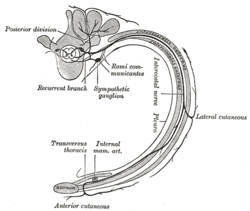Ramus communicans
| Ramus communicans | |
|---|---|
 Scheme showing structure of a typical spinal nerve. 1. Somatic efferent. 2. Somatic afferent. 3,4,5. Sympathetic efferent. 6,7. Sympathetic afferent. | |
 Diagram of the course and branches of a typical intercostal nerve. (Rami communicantes labeled at center.) | |
| Details | |
| Identifiers | |
| Latin | ramus communicans nervorum spinalium |
| Dorlands /Elsevier | r_02/12689477 |
| TA | A14.2.00.033 |
| FMA | 5874 |
Ramus communicans (plural rami communicantes) is the Latin term used for a nerve which connects two other nerves, and can be translated as "communicating branch".
Structure
When used without further definition, it almost always refers to a communicating branch between a spinal nerve and the sympathetic trunk. More specifically, it usually refers to one of the following :
The grey and white rami communicantes are responsible for conveying autonomic signals, specifically for the sympathetic nervous system. Their difference in coloration is caused by differences in myelination of the nerve fibres contained within, i.e. there are more myelinated than unmyelinated fibres in the white rami communicantes while the converse is true for the grey rami communicantes.
Grey ramus communicans
The grey rami communicantes exist at every level of the spinal cord and are responsible for carrying postganglionic nerve fibres from the paravertebral ganglia to their destination, and for carrying those preganglionic nerve fibres which enter the paravertebral ganglia but do not synapse.
White ramus communicans
The white rami communicantes exist only at the levels of the spinal cord where the intermediolateral cell column is present (T1-L2) and are responsible for carrying preganglionic nerve fibres from the spinal cord to the paravertebral ganglia.